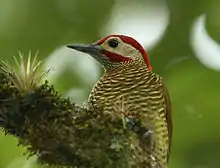Golden-olive woodpecker
The golden-olive woodpecker (Colaptes rubiginosus) is a resident breeding bird from Mexico south and east to Guyana, northwest Argentina, Trinidad and Tobago. It was formerly placed in the genus Piculus.[4] The scientific name rubiginosus means "full of rust", describing the color of the bird's wings and back.
| Golden-olive woodpecker | |
|---|---|
 | |
 | |
| Male above, female below | |
| Scientific classification | |
| Kingdom: | Animalia |
| Phylum: | Chordata |
| Class: | Aves |
| Order: | Piciformes |
| Family: | Picidae |
| Genus: | Colaptes |
| Species: | C. rubiginosus |
| Binomial name | |
| Colaptes rubiginosus | |
 | |
| Synonyms[2][3] | |
| |
Description
The golden-olive woodpecker is 20 cm (7.9 in) long and weighs 75 g (2.6 oz). Adults are mainly golden olive above with some barring on the tail. The forecrown is grey and the hindcrown red. The face is yellow-white and the underparts are barred black and yellowish. The bill is black. Adult males have a red moustachial strip which is lacking in the female.[5]
Habitat and ecology
The habitat of this woodpecker is forests, more open woodlands and cultivation. It is most common in the mountains. Two or three white eggs are laid in a nest hole in a tree and incubated by both sexes. The young are fed by regurgitation.
Due to its habitat-mainly montane forests, separated by large rivers-it has evolved into about 20 subspecies. P. r. tobagensis from Tobago is larger and heavier-billed than P. r. trinitatis from Trinidad. Some of the South American subspecies have only very narrow yellow barring on the underparts and the Andean subspecies show a pale eye ring.
Golden-olive woodpeckers mainly eat insects, including ants and beetle larvae, with some fruit and berries. The call of this bird is a loud wheep.
References
- BirdLife International (2014). "Colaptes rubiginosus". IUCN Red List of Threatened Species. 2014. Retrieved 6 March 2016.CS1 maint: ref=harv (link)
- Handbook of the Birds of the World. vol. 7. 2002.
- "Piculus aeruginosus". Avibase.
- Benz, Brett W.; Robbins, Mark B.; Peterson, A. Townsend (2006). "Evolutionary history of woodpeckers and allies (Aves: Picidae): Placing key taxa on the phylogenetic tree". Molecular Phylogenetics and Evolution. 40: 389–399. doi:10.1016/j.ympev.2006.02.021. PMID 16635580.CS1 maint: ref=harv (link)
- Stiles, F. Gary; Skutch, Alexander F. (1989). A Guide to the Birds of Costa Rica. Ithaca, NY: Cornell University. p. 256. ISBN 978-0-8014-9600-4.
Further reading
- Skutch, Alexander F. (1969). "Golden-olive woodpecker" (PDF). Life Histories of Central American Birds III: Families Cotingidae, Pipridae, Formicariidae, Furnariidae, Dendrocolaptidae, and Picidae. Pacific Coast Avifauna, Number 35. Berkeley, California: Cooper Ornithological Society. pp. 422–427.
External links
| Wikimedia Commons has media related to Colaptes rubiginosus. |
| Wikispecies has information related to Colaptes rubiginosus. |
- Golden-olive woodpecker stamps from El Salvador, Nicaragua and Trinidad and Tobago at bird-stamps.org
- BirdLife species factsheet for Colaptes rubiginosus
- "Golden-olive woodpecker media". Internet Bird Collection.
- Golden-olive woodpecker species account at Neotropical Birds (Cornell Lab of Ornithology)
- Interactive range map of Colaptes rubiginosus at IUCN Red List maps
- Audio recordings of Golden-olive woodpecker on Xeno-canto.
- Colaptes rubiginosus in Field Guide: Birds of the World on Flickr
